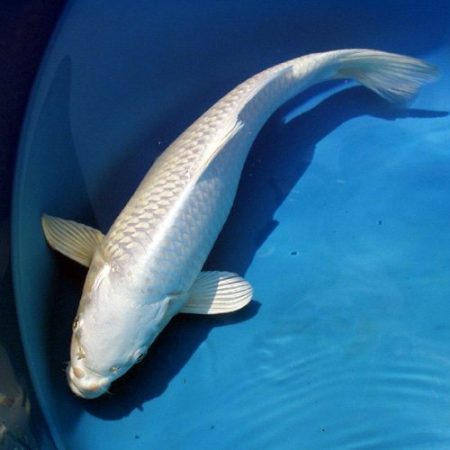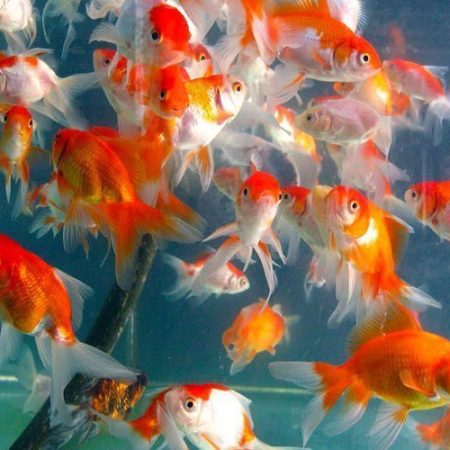Howdy Friends! Our family’s farm is indeed shipping Livestock & Plants proactively! Please read our Shipping Schedule for details. Order a box of happiness Today! We’re here to take loving care of your orders! ❤️
$4.99
*NOTE: AS A FISH FARM, WE DO NOT OFFER GENDER SPECIFIC SEXING ON FISH STOCK. REQUEST FOR MALES OR FEMALES CAN ONLY BE ACCOMMODATED IF THE ITEM SPECIFIES GENDER IN THE DESCRIPTION SUCH AS: MALE BETTA, FEMALE GUPPY, ETC SORRY FOR ANY INCONVENIENCE.
Out of stock
Bullfrog tadpoles have a light green to dark olive green color with dark spots and blotches. Juveniles have many small dark spots. Sometimes light green only on the upper jaw. Cream to yellow below with grey marbling on larger individuals. Tadpoles are greenish yellow with small spots, growing up to 6 in. (15.3 cm). Bullfrogs and tadpoles are upalatable to many predators. Adults and juveniles are capable of hopping large distances, and when disturbed, they will hop into water and dive down.
The American Bullfrog is native throughout most of the midwestern, eastern and southern USA, reaching north as far as Canada, and south just below the Rio Grande River in Texas, and west to New Mexico and Colorado. It has also been introduced for food around the world in Hawaii, Mexico, Europe, Asia, South America, the Caribbean Islands, Brazil, and Cuba.
It inhabits warm, sunny, open, permanent water – lakes, ponds, reservoirs, marshes, slow river backwaters, irrigation canals, cattle tanks, and slow creeks. Bullfrog tadpoles are found in grassland, farmland, prairies, woodland, chaparral, forests, foothills, and desert oasis.
The Bullfrog is distinguished from other frogs by the large external eardrum under each eye and the fully webbed hind feet except for the last joint of the longest toe. Bullfrogs are commonly used as dissection specimens in biology classrooms. They were subject of some pioneering studies in evolutionary biology in the 20th century, and continue to be of much interest to various disciplines of biology.
A loud low-pitched two-part drone or bellow, popularly described as “jug-o’rum.” These calls are made during the day and at night. Bullfrogs also produce an alarm call, a fast squeak, which is usually made before the frog jumps into the water to escape from danger. A sharp encounter call is also made, and a loud open-mouthed screaming sound is made when a frog is under extreme stress.
Highly aquatic. Rarely found far from water. Active day and night. When startled, usually emits a chirp or squeak, then jumps into the water. Prefers a relatively high body temperature and becomes active later in the spring in some areas. In areas with freezes in winter, bullfrogs hibernate under water buried in mud or laying on a pond bottom. Longevity in the wild is thought to be 8-10 years, but captive specimens have lived nearly 16 years.
Diet: Eats anything it can swallow, including invertebrates, mammals, birds, fish, reptiles, and amphibians including other bullfrogs. Bullfrogs sit and wait for food to come near them, then they lunge after it. It is likely that bullfrogs hunt and eat other frogs after hearing their breeding or distress calls. Tadpoles eat algae, aquatic plant matter, mosquito larvae, and some invertebrates.
Reproduction and Young: Reproduction is aquatic. Fertilization is external. Mating and egg laying occurs mostly from May to late August (but in some areas it occurs as early as March and as late as October.) Reproduction begins when the air temperature reaches a certain level (measured at one location in Kansas at 21 degrees C., or about 70 degrees F.)
Males are mature in 1-2 years & females 2-3 years, then breeding occurs from February to October. Males will set up a territory and make a call at night or even during daylight. Males will defend their territory from other males. Females choose her mate by entering a male’s territory. Eggs are laid in jelly-like sheet about 2 feet in diameter. The egg mass floats at first, then will sink toward underwater plants just before hatching in 3 – 5 days.
Tadpoles enter metamorphosis anywhere from a few months in the South to the end of their 2nd or 3rd summer in places like WI, MI, or IL. In most of warmer states like CA, TX, AZ, FL & more, transformation probably occurs after the second summer. Tadpoles prefer areas of warm shallow water with dense aquatic plants like hornwort, or Elodea. Transformed froglets are 2 in. (5 cm.) in length.
Ideal for feeding on Mosquitoes, Mosquito Larvae and other flying insects. This frog can also be used as a food source for small and large gamefish, and birds as well.
Shipped as tadpoles only varying in size and morph stages depending on the time of the year. Tadpoles generally ship very well, and will be an important part of your ecosystem once introduced to your pond.
| Tadpole Type Choice: | American Bullfrog Tadpoles, Leopard Frog Tadpoles |
|---|




